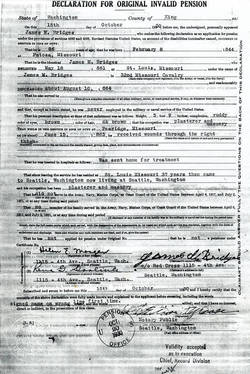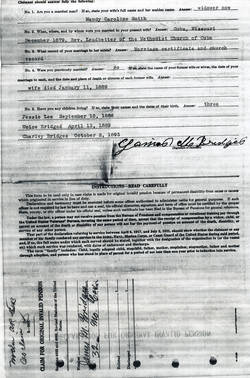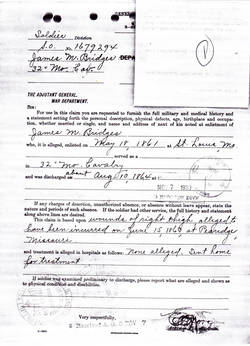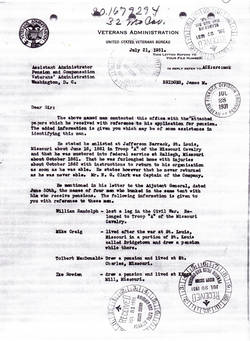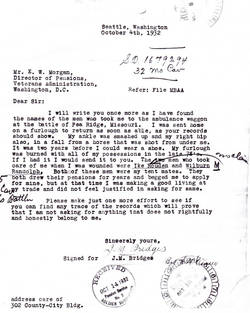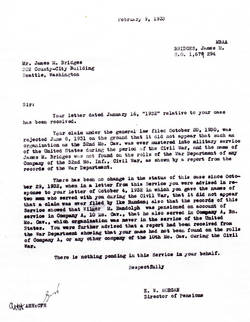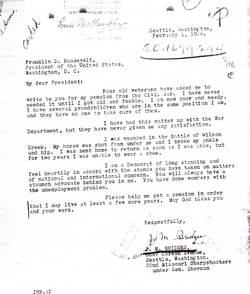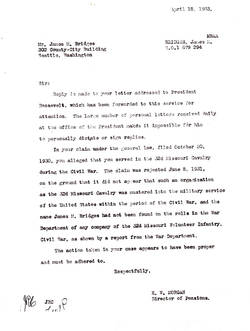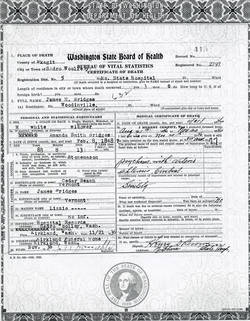Full Unit History
James Madison Bridges is buried in the Woodinville Memorial Cemetery located in downtown Woodinville, King County, Washington. During the early 1900s, when at least one pioneer family of that community - the relatives of Senaca Phillis who is also buried there - visited the burial ground to place flowers on the graves of Civil War veterans buried therein, one of the graves they always put flowers on was that of James Bridges. Was he a veteran of America’s War Of The Rebellion? Perhaps, yes. Likely, no. You decide. Here is the cloudy, somewhat sad, tale of James Bridges.
Family History
According to James, he was born on February 8, 1844 in Patosa, Missouri. (Unfortunately, no such name appears on current maps.) The 1880 U.S. census stated that he was born in Missouri, not in 1844, but in 1846. According to James' death certificate, based on hospital records, he had been birthed on 2/8/48 in Cedar Beach, Vermont. Finally, the census for 1900 claimed he was born in 1856 either in Illinois, or in Missouri, along the border of those two states.
As best as can be determined, James' father was also named James. He was reportedly born in Vermont. His mother was likely Elizabeth "Lizzie" (no nee b. TN [?]) Bridges. There is no further information pertaining to his parents or possible siblings. Further, nothing is known about James' childhood or formative years.
On May 18, 1861, at Jefferson Barracks located near St. Louis, MO James allegedly joined the U.S. army as a cavalry trooper in a Missouri regiment. Interestingly, he could never provide verifiable company or regimental information pertaining to that military organization. At enlistment his vital stats were supposedly as follows: Height = 5'9"; Complexion = ruddy; Eyes = brown; Hair = dark brown; Occupation = plasterer and (stone) masonry.
Throughout the story of James' alleged military history there is a common thread. According to that thread he was in action between March 6 – 8, 1862 at the battle of Pea Ridge / Elk Horn Tavern in Missouri. However, he also says the battle took place between the 18th or 19th of June, 1861. During that action his horse either fell or was shot from under him. The horse and saddle then pinned him to the earth, breaking his right hip and ankle.
After the battle James claims that he was furloughed to his uncle’s Missouri home and told to remain there until he was well enough to return to duty. That date never came. According to James, he could not put a shoe on his injured foot for two or two and a half years. As we shall see, the basic story remains the same while the details surrounding it fluctuate wildly.
*************************************************************************************************
The exact whereabouts of James during the 1870 U.S. Census is not documented. However, he was reportedly in Missouri. What is known is that on 12/14/75, in Crawford County within that state, he wed Amanda "Mandy" Caroline Smith (b. 1856 or '59 MO). According to family lore, Amanda may have been of Native American Heritage.
Where James and Amanda settled after their wedding is not known. However, again turning to family lore, the couples' children were all (born and) raised in Cuba, Crawford County, Missouri. Those children were: Adelaide (sp?)"Allie" May (b. 1877 MO), Elizabeth J. (b. 1878 MO), Benjamin Duthon/Duthan/Dathan (b. 1882 Cuba, MO), Emma (b. 1884 MO), Jessie L. (daughter b. 9/20/86), Charles "Charlie" Edward (b. 10/12 or 12/10/1887 Cuba, MO), Eunice (m.i P? b. 4/13/89) and Emmanuel (b. 1893 MO). The last two births are interesting because Amanda allegedly died on 1/1/89.
In the census of 1900 James and five of his youngest children were noted as living in Benton, Scott Co., MO. He, the head of the family, was employed as a farm laborer. By the following year James had moved from Missouri to Seattle, King County, Washington. What brought him west is not documented. Had a relative or one or more of his older children moved here and prompted him to come west? Also not documented is what, if anything, he did with his younger children. Did he abandon them in Missouri? We may never know the answer to that question. In Seattle James allegedly plied his trade as plasterer and stone mason.
*************************************************************************************************
During the near thirty years following James' westward movement to Seattle, he completely falls off the radar screen. There is virtually no documental information pertaining to where, exactly, he was residing or what he was doing to earn a living. The first sighting of him comes from October 15, 1930 when, with the help of another in Seattle, he began a campaign to obtain a U.S. Government disability pension based on his claimed military service during the Civil War. This campaign would prove to be both interesting and heart wrenching.
The first step in what was to be a futile four year letter writing and paperwork struggle was made in the form of a 10/15/30 pension application which included, in part, the following: Age 86; Born 2/8/44 Patosa, MO; enlisted 5/18/61 St. Louis, MO in the 32nd Missouri Cavalry from which he was discharged 8/10/64.
In that application he laid out the injury scenario related earlier herein which, he claimed’ occurred at Elkhorn Tavern/Pea Ridge on 6/10/63. (As we have seen the battle of Pea Ridge /Elkhorn Tavern was fought not in 1863, but in 1862.) At the time of this application James may have been residing at 1115 4th Avenue, Seattle, but his return mailing address was c/o of The Red Cross in that city. The government response, which came on 11/8, pointed out there had been no 32nd Missouri Cavalry and James' name could not be located on the rolls of the 32nd Missouri Infantry.
In response to the rejection, on 2/23/31 a type-written statement signed by James was returned to Washington D.C. The statement , in part, read as follows: "I, James M. Briges, age eighty six, residing in Seattle, Washington and being duly sworn on oath according to law deposes and states That, I enlisted in Co. A of the 32nd Missouri Cavalry on May 18, 1861 and was discharged August 10, 1864.That Lt. John Wilson was an officer in Co. A. N.G. Clarke was the Captain and the Regiment was in command of General Sherman. That I served approximately one year and ten months and was then sent home on furlough owing to injury received when thrown from a horse, but did not receive my discharge until August 10, 1864."
The 4/4/31 governmental reply was: "The service of James M. Bridges has not been identified...One Nathaniel G. Cark served as captain of Company E, 32nd Missouri Volunteer Infantry (Infantry underlined), Civil War. However, the name John Wilson has not been found as a Lieutenant of Company E, Company A or any other company of that regiment."
On 6/30/31 the following was returned to The War Department in Washington: "I do not understand why you cannot find my name in the records of the Illinois Cavalry or in the Missouri Cavalry, during the Civil War." After the recounting of his enlistment, injury and furlough home came this: "I served with these men whose names should appear on your records: (Wilburn) Randolph; Mike Craig; Tolbert MacDonald, Ike Rowden. These four men drew pensions. They were my tent mates. These four men could give you sufficient proof of my service during the Civil War. I first served under General Sherman, but before the Battle of Pea Ridge I was transferred to General Brown." The preceding was forwarded to The Veterans' Administration where, once again, the pension plea hit a dead end. The government response was as follows: "we find no record of Mr. Bridges' service".
Another letter was then “penned" on 10/29/31 and directed to U.S. Congressman Ralph Horr, (1931 - 1933 1st Dist. R) House of Representatives, Washington, D.C. "Five months ago I tried for my pension. I have been advised to write you and I will get good returns. The proof they have should be sufficient, four witnesses that I served with the Cavalry Navy......I never applied for my pension before until I got old and crippled. I stood before the bullets to defend our country and I need my pension. Please answer by return mail and send me my check for all back pay."
The above was passed along to the Pension Office and then to the Veterans Administration but, once again, no pension.
James then sent a hand written missive to President Herbert Hoover:
"I have written a number of times to the navy dept. The answers are no good. Honest in all my statements, I went through lots of hard duty. Honest, for our country (The Pea Ridge/furlough saga was then recounted)....I am old and feeble. I am entitled to what I have called. Don't leave it to the war department. They wouldn't do what I had to do for my money. Please send me my back pay and monthly pension. I look to you. God Bless." The Department of The Navy replied: “There is no record of this man in the U.S. Navy."
Following the navy's reply, on 9/13/32 another typed letter was sent from Seattle to the Veterans Administration in Washington, D.C. "In answer to your letter my proof is all good that I have ever sent to you. Honest and straight as you said in your letter. There is no reason why I should not have what is coming to me. Stood for our country, fought for it and the same today and will remain. I might offer for proof that I was under General Brown, Lt. Wilson and Capt. Clark. As your records show my furlough was burned in 1877 with my house and all my personal belongings. This statement is true. Two years I could not wear a shoe, I could not return as I was not able. There is no reason why they should not send me my back pay."
Enclosed with this letter was the following: “I have just typed the enclosed letter for Mr. Bridges, and cannot refrain from adding just a few words to help, if possible, this dear old soul. Have been employed the County Agricultural Agent for the greater part of fifteen years and in that time come in contact with many people, all of whom were good, bad or indifferent and can say in all of these years have never met an old person with the charity of heart and goodness of soul like that contained in the person of Mr. Bridges. His past performance I do not know, and I cannot throw any light on his war record, but I do feel that if anything can possibly be done to locate his enlistment record or any record that can identify him with the Civil War, so that he can obtain his pension, it will be a worthwhile service for a worthwhile citizen.
He is getting very old and feeble and is not long for this world as he fully realies but he always has a smile and a kind word for everybody and I am sure if this error was his, it through his happy carefree disposition which leads him to believe that the future would take care of itself. But as you may know, there comes a time in everyones life, sometimes early and sometimes late, that he comes face to face with the reality of life. would like I am sure that the last couple of years for this man have been very hard, due mostly to lack of funds and for this reason, I for one would like to see this old gentleman laid to rest with a peaceful heart, believing that the country he fought for had fought for him in his hour of need."
On 10/4/32 another letter to the VA:
"I will write to you once more as I have found the names of the men who took me to the ambulance wagon at the battle of Pea Ridge, Missouri. I was sent home on a furlough to return as soon as able. My ankle was smashed up and right hip, also.........It was two years before I could wear a shoe. My furlough was burned with all of my possessions in late '78's. If I had it I would send it to you. The two men who took care of me when I was wounded were Ike Rouden and Wilburn (M) Randolph. Both of these men were my tent mates. They both drew their pensions for years and begged me to apply for mine, but at that time I was making a good living at my trade and did not feel justified in asking for same.
Please make just one more effort to see if you can find any trace of the records which will prove that I am not asking for anything that does not rightfully and honestly belong to me."
According to pension office findings, Ike Rouden had never filed a pension claim, so they had no records on him. Randolph had served in company A of the 10th Missouri Cav, but James Bridges' name did not appear on the rolls of Co. A or any other company of the 10th. Finally, no organization known as Brown's Battalion Missouri Cavalry was mustered into the military service of the United States within the period of the Civil War.
On February 14, 1933 James replied:
"In answer to your letter I just received, honest and straight, in all the evidence I have given you is true. There is no reason why I shouldn't have my back pension." Next, the wounding/furlough scenario was once again presented. The missive closed with this paragraph "I was burned out in 1886 furlough and all, including my old veteran clothes. My history is all true and honest all through life. There is no reason why you shouldn't send me what is just and honest. There wouldn't be one of you go through what I did for my money."
Next, on 3/22/33 James sent another letter to the president of the United States who, by this time, was Franklin Delano Roosevelt:
"This is a Civil War Veteran, I have tried for two years to get my back pension. The War Department cannot find my name. I am old and feeble. Eighty eight years old, I was wounded in the battle of Wilson Creek Missouri, I was crippled from a horse being shot from under me, broken ankle and hip, I was sent home on a furlough to return as soon as I was able, two years before I could wear a shoe. I never had a discharge. The war was over before I could return. I wrote a number of letters they couldn"t find my name, in the excitement, it was neglected. You show them that you have charge of everything. I am entitled to all back pension. Please answer by return mail." The letter was signed J.M. Bridges his mark X.
The Office of The President forwarded the preceding letter to the Pension Department. On 4/18/33 E.W. Morgan, Director of Pensions, replied:, "Reply is made to your letter addressed to President Roosevelt, which has been forwarded to this service for attention. The large number of personal letters received daily by the office of the President makes it impossible for him personally dictate or sign.
It is your claim under the general law, filed October 20, 1930, you alleged that you served in the 32nd Missouri Cavalry during the Civil War. The claim was rejected June 8, 1931, on the ground that it did not appear that such an organization as the 32nd Missouri Cavalry was mustered into the military service of United States within the period of the Civil War, and the name James M. Bridges had not been found on the rolls in the War Department of any company of the 32nd Missouri Volunteer Infantry, Civil War, as shown by a report from the War Department.
The action taken in your case appears to have been proper and must be adhered to."
The above quoted letter was directed to James at 302 County-City Building Seattle, Washington.
On May 12, 1933 James responded with the following hand written message directed to the War Department:
"In answer to your letter, all the proof I have given you is correct and honest. When I was crippled at the battle of Pea Ridge I was sent home on furlough to return as soon as able. Over two years before I could wear a shoe. Through some oversight name was not put on (the) list. It is not necessary to (illegible) up those names, honest man all my life. I am now 88 year past. I am entitled to all back pension by return mail. Yours Truly, J.M. Bridges (over)
I wish I could send you my cavalry suit that burnt up with the furlough all when I was away from home at work. May God bless you (underlined), send me what's mine."
Typed letter dated 2/1/34.:
Franklin D. Roosevelt
President Of The United States
Washington, D.C.
"My Dear President,
Four old veterans have asked me to write to you for my pension from the Civil War. I have never needed it until I got old and feeble. I am now poor and needy. I have several grandchildren who are in the same position I am, and they have no one to take care of them.
I have had this matter up with the War Department, but they have never given me any satisfaction.
I was wounded in the Battle of Wilson Creek. My horse was shot from under me and I broke my ankle and hip. I was sent home to return as soon as I was able, but for two years I was unable to wear a shoe.
I am a Democrat of long standing and feel heartily in accord with the stands you have taken on matters of national and international concern. You will always have a staunch advocate behind you in me. You have done wonders with the unemployment problem.
Please help me get a pension? order that I may live at least a few more years. May God bless you and your work."
The letter closed as follows: J.M. Bridges 6647 Corson Avenue Seattle Washington 32nd Missouri Sharpshooters under Gen. Sherman.
One final response was sent to James over the signature of E.W. Morgan, Director of Pensions. In that letter he summarized all the prior pension inquiry actions and, in closing, noted "There is nothing pending in this service on your behalf". Thus ended the ping pong game of pension letters. Case closed.
*************************************************************************************************
James Madison Bridges died November 21, 1936. The place of his passing was Washington's Northern State (mental) Hospital located in the Skagit County community of Sedro Woolley. The circumstances of his residence there and when that placement had occurred is not documented. Cause of death was listed as "Psychosis with arteria sclerosis - cerebral." Contributing was "Senility."
Interestingly, although there is no documental evidence connecting him to the community, the Death Certificate listed James' community of residence as Woodinville, King County, Washington. Woodinville was, at that time, a small, rural town located slightly northeast of Seattle. According to a family source, there was a relative - perhaps a sister - residing there. One of his daughters may also have been living in the area.
James' earthly remains were handled by the Kirkland Funeral home of Kirkland, King County, WA. Interment was in the Woodinville cemetery. A headstone marks the gravesite. In later years two of James' sons, Benjamin and Charlie, were buried beside him. Their graves are reportedly not marked.
Cemetery
Buried at Woodinville Memorial Cemetery

